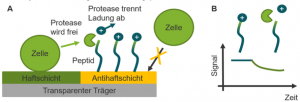MULTISENSE
Multiparametric sensors for real-time analysis of inflammatory processes
The release of proteases plays an important role in many inflammatory processes both in peripheral organs and in the central nervous system. Essential aspects of the time- and site-dependent effects of the released proteases are still insufficiently understood at the cellular and subcellular level. Therefore, there is a great need for new time- and spatially-resolved analytical methods and technology platforms that allow highly parallel, non-invasive analysis of protease activity at the cellular and subcellular level. Synchronous recording of other parameters such as morphology, electrical activity or oxidative stress in real time would be helpful in order to open up new fields of application in diagnostics and therapy through an even more precise understanding of cell type-specific reactions.
Transparent nanostructured biosensors represent a possible solution for the requirements described. The aim is to develop a biosensor platform with transparent electrodes for analyzing cells. A particular focus is on the parallel detection of several important proteases that play an important role in various pathophysiological processes of immune defense and in neurodegenerative diseases. To detect the respective protease activity, a novel potentiometric detection method is to be used for the first time, in which synthetic peptides with strong N-terminal charge carriers are immobilized on the biosensors (Fig. 1A). Various aspects of biosensor development are being comprehensively investigated as part of the interdisciplinary project. In the future, further development and miniaturization of the overall system towards diagnostic procedures is planned in cooperation with companies.

Project management:
Prof. Dr. Bernd Bufe, Prof. Dr. Alexey Tarasov, Prof. Dr. Monika Saumer, Dr. Kristina Endres, Prof. Dr. Christiane Ziegler, Prof. Dr. Tanja Schirmeister, Dr. Christian Kersten
Project partner:
Kaiserslautern University of Applied Sciences, Kaiserslautern University of Technology, Johannes Gutenberg University Mainz
The project is funded by the Forschungskolleg Rheinland-Pfalz